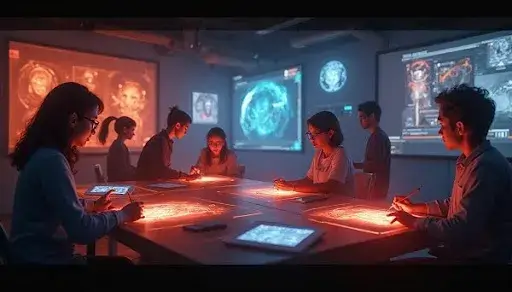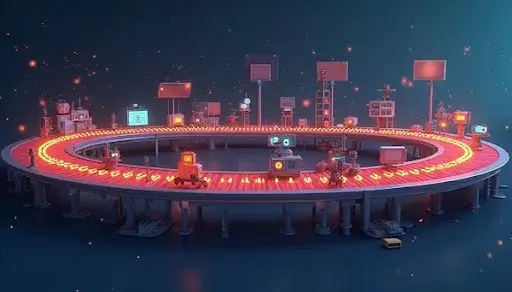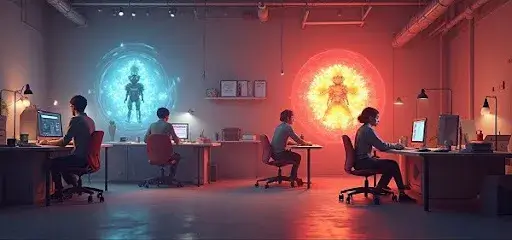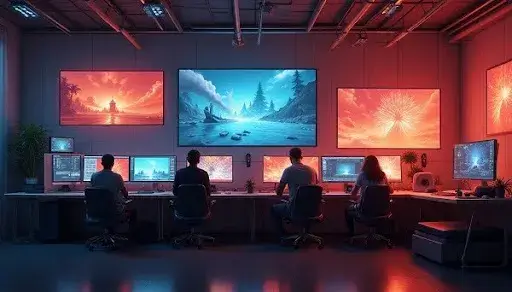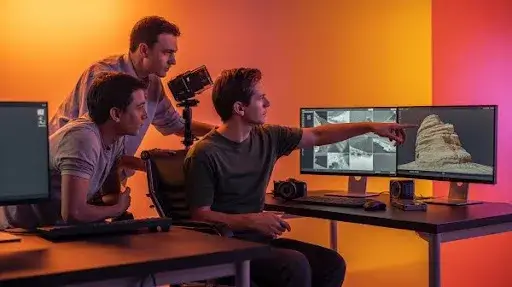A 3D animation does not start with rendered frames, nor does it end with stunning visuals. The only thing visible is a “moving parts” animation, with a pipeline holding everything together. A blank screen is all there is.
And that pipeline? It’s not just some fancy industry word. It’s the only way animation projects stay on track — from idea to delivery.
It doesn’t matter whether you plan to delve into 3D content or you want to learn how Prolific Studio, one of the best animation studios in Reno, captures stunning visuals and animations.
The 3D animation pipeline is fascinating. In this instance, there is no need to fluff my explanation, and I will explain thoroughly how 3D animation processes are done in 2025.
What Is a 3D Animation Pipeline?
Animation pipelines are very common in studios. It is usually a structured process for production. While every studio operates differently, there is a trick to every single one of them: there is a 3-step process, and it is divided into parts and structured for classification to ensure that studio pipelines are as orderly as possible, allowing for a seamless professional result.
Each phase — from pre-production to post-production — has dedicated teams, specific tools, and goals. The purpose is to make sure no step is skipped, and no creative effort gets lost in confusion.
The 3D animation pipeline isn’t optional. It’s the backbone of every successful 3D animation studio’s process.
The Pre-Production Phase
What is Pre-Production in the Animation Pipeline?
Pre-production is the planning stage. The time when decisions are made, ideas are developed, and the animation starts to take shape on paper (and screen). Without solid pre-production, you’re flying blind — and that’s how budgets spiral out of control.
Here’s how the 3D animation production pipeline begins:
1. Idea Development
Every animation starts with a concept. This can be a character, a short story, or a whole setting. An idea has to be formulated clear enough to expand on it and pitch.
In this case, the idea has to be scoped out properly, ensuring it can be executed within the studio’s deadlines, resources, and tools on hand, as well as the studio’s team capabilities.
2. Story and Scriptwriting
Once the idea clicks, it’s time to craft the story. It is easy to establish a beginning, middle, or end for a story. However, stakes, tension, or framework are not easy to come up with. Take a poorly structured script as an example.
Coding is removing a robot user with no footage. A bespoke story writer will turn it into a smooth framework that is brought to life through scenes, dialogue, and actions.
Writers also prepare two types of scripts:
- A narrative script, which outlines the general flow.
- A technical script, used later to guide animators, editors, and voice artists.
3. Storyboarding
This is where the visual ideas in a 3D animation pipeline start to show up.
A storyboard is a sequence of still drawings that maps out each shot of the animation. Scrapboards save the studio and artists hours of refinement. Each member involved can track the visuals and plans, avoiding the need to start production from scratch.
Think of it like a blueprint. No one builds without one.
4. Animatics
Storyboards are helpful, but animatics take things further. An animatic is basically a moving storyboard — still rough, but timed to audio and action beats.
It shows pacing, scene changes, and camera angles. It also gives the team something to review and revise before committing to full production.
5. Concept Art
The next step in the animation workflow or pipeline is visual design.
The final design is done by the directors. What concept artists do is everything from costume characters to environments to sketches. The goal of concept artists is not to design, but rather to sketch and explore visuals to ensure that the story and animation are complemented.
Once that visual direction is approved, it’s locked for the production team.
The Production Phase
Here’s where the pipeline gets intense. Artists, designers, modelers, and animators bring the story to life with movement, lighting, sound, and realism.
This part of the production pipeline for 3D animation includes multiple departments working simultaneously. Communication and clarity are everything.
6. 3D Layout
3D layout artists build rough versions of every shot, using simple shapes and placeholder models. These previews help define framing, camera moves, and overall composition, just like cinematography in a live-action film.
7. 3D Modeling
Now it’s time to build the characters, props, and sets in full 3D.
Modelers sculpt geometry for everything that will appear on screen. Whether it’s a stylized character or a hyper-realistic dragon, this step shapes the physical form of every object in the scene.
And yes, it’s as detailed as it sounds. Artists use references, blueprints, and anatomy guides to get every edge and curve right.
8. Texturing
Here comes the skin.
In texturing, which is a part of the 3D animation production process, artists apply surface details such as color and wood grain to 3D shapes – clothes, skin pores, and rust. Artists form textures called maps, which are fitted on 3D geometry where depth and detail are added.
A metal sword won’t shine on its own. It needs materials, reflections, and tiny imperfections to look real.
9. Rigging
You can’t animate a character if it can’t move. Rigging solves that.
Rigging adds an internal skeleton to characters so animators can move them naturally. Eyes, arms, legs, wings — everything needs controls. And each rig must match the character’s body and motion style.
Complex rigs can have hundreds of bones and controls, and if even one is off, the entire movement will look odd.
10. Animation
This is the stage most people think of when they hear “animation.”
Here, animators take the rigged models and start creating motion. They do lip sync, and walking to jumping, and running, and even rather dramatic acting. Whether an animal or a robot, the animation should always be lively.
This part takes time. Weeks, sometimes months, depending on the shot complexity.
11. Visual Effects (VFX)
Once basic animation is locked, VFX artists step in.
They do the complex work of creating fire, water, smoke, and even explosions, weather, and magical effects. These elements look cool and also enhance the story’s realism.
This part of the 3D animation production pipeline can blur the line between real and animated.
12. Lighting
Lighting artists set the mood of every shot — happy, scary, dramatic, or serene.
Lighting is to visibility as lighting a scene is to emotional expression, cohesion, or narrative flow. Inside the 3D programs, virtual lamps, sun, neon lamps, and even the moon can be mimicked with virtual lights.
Poor lighting can ruin great modeling. Good lighting can elevate average visuals.
13. Rendering
This is the moment all that work becomes something you can actually watch.
Every element, such as models, textures, lighting, animation, and effects, is the key to rendering. This step is particularly resource-heavy. Quality also matters to time investment, with frames taking from minutes to hours in the case of a single, excellent frame.
Studios often render in layers (background, shadows, highlights, etc.) to give editors more control later.
The Post-Production Phase
What Happens in Post-Production in the 3D Animation Pipeline?
Now the team assembles, enhances, and finalizes everything for delivery. No more modeling or movement — just polish, presentation, and output.
14. Compositing
Compositors blend the rendered layers to form the final frame. This includes combining character animation with backgrounds, visual effects, and lighting. They also adjust depth, add motion blur, or fix any inconsistencies.
It’s the invisible glue that holds scenes together.
15. 2D VFX
Some details work better when you opt for 2D animation services rather than 3D. Think raindrops, smoke trails, sparks, or dust. These effects are layered in during compositing to give subtle movement and realism.
Used properly, they make a big difference without stealing attention.
16. Color Correction
Even after lighting and rendering, color tweaks are usually needed.
Colorists balance tones, adjust exposure, boost contrast, and match shots for continuity. This ensures every scene looks consistent and polished.
17. Final Output
In the case of animation, it is released in a form that is suitable as per the requirements, be it for YouTube, TV, web, film, streaming applications, or any other form of delivery.
Deliverables are to be presented in line with the studio’s expectations. The animation needs to be trimmed in a file without compromising the visual quality, such as maintaining the quality, resolution, and file size.
Why Use a Pipeline for 3D Animation Production?
Some studios try to skip this structure early on. That’s usually when things fall apart.
The pipeline for 3D animation production isn’t just a best practice — it’s essential. You’re coordinating artists, software, machines, and creative expectations. And without a system, one late asset can stall a whole team.
Here’s why a structured pipeline keeps animation studios from drowning in missed deadlines and overblown budgets.
Time Management
Animation is slow. It is an overwhelming timeline to build for 90 minutes, but if you surrender, the animation workload would require a heightened production schedule, calculated to nearly weeks to complete a second of work.
Each stage in the animation pipeline procedure has its own deadline, and they all connect like gears. If the layout runs late, rigging can’t start. If the lighting is behind, rendering stalls. A clear pipeline helps teams plan accordingly and avoid bottlenecks.
No one wants surprises at 2 AM before a delivery date.
Financial Management
Without a pipeline, tracking costs becomes a nightmare.
In the 3D animation production pipeline, budgeting starts in pre-production. Teams estimate how many resources (time, artists, render hours, software licenses) each step will take. This early clarity avoids unplanned hiring, overextended animators, or reshoots due to miscommunication.
Studios that skip this? They usually overspend fast and burn out their teams.
Team and Structure Management
One project might need five people. Another might need 150. In both cases, structure is what keeps the chaos in check.
Every step of the pipeline is assigned to a different team, allowing work to be divided among modelers, riggers, animators, lighting artists, compositors, and others. There is order, and everyone understands the prerequisites and expectations.
This isn’t just management — it’s survival.
A reliable animation workflow or pipeline avoids overlaps, rework, and unnecessary meetings. It sets up accountability and transparency.
What Makes a Pipeline Work in 2025?
The tools and roles change. The fundamentals stay the same.
Today’s 3D animation production pipeline runs on more automation, faster rendering engines, and cloud-based collaboration. But these modern upgrades still depend on old-school discipline — clear communication, documented processes, and quality control.
Studios are also getting smarter with:
- Real-time previews: Layout teams can now test lighting and animation faster with game-engine-style feedback.
- Virtual production: Teams shoot scenes inside 3D software with VR tools and motion capture rigs.
- Asset libraries: Reusable characters, props, and shaders save time and boost consistency across projects.
In short, it’s no longer about how advanced your software is — it’s about how smartly you organize your pipeline.
FAQs About the 3D Animation Pipeline
What is an animation pipeline?
It is a comprehensive sequential procedure utilized by studios to produce animated content, from story conception to the final rendering. A pipeline makes sure that components of a project are accomplished in a sequential manner, with the proper team, and that there are defined results in hand.
What is pre-production in the animation pipeline?
Pre-production is the first phase of a project and includes idea generation, scripting, storyboards, drafting concept art, and creating animatics. The creative direction and logistics of the project are set in this stage.
How long does the 3D animation production process take?
That depends on complexity. A short video may take 6–10 weeks. An example is a full-length animated feature. This can take anywhere between 12 and 24 months. Each phase of the project, including modeling, animating, creating rigging, and adding VFX, is based on the project's details and the resources available.
How many people work on a 3D animation pipeline?
For smaller projects, there is a lean team comprised of 5-10 people. For larger projects, there are over 100 people in multiple departments, including TV series and movies. This is why structure and communication are so important.
What’s the difference between production and post-production?
Production is the stage where all 3D assets are built and animated, while in post-production, assets are assembled, refined, and completed for rendering.
Can 2D effects be part of a 3D animation pipeline?
Yes. During compositing, many effects such as smoke, sparks, or rain are added in 2D. This increases the realism of a project while making sure the full 3D rendering isn’t slowed down.
What software is used in the animation workflow?
For drafting, editing tools or software such as Premiere and Da Vinci Resolve are used. For 3D modeling, an animated feature or show, use the Filter software. For effect rendering, use Houdini, Maya, Blender, or Cinema 3D as VFX tools. Studios have their tools and filters based on budget and teamwork authorization.
Final Word
The process that leads to visuals in animation is far more intricate and interesting than the visuals themselves.
The entire production team benefits from a solid 3D animation pipeline. With a smoother 3D animation pipeline in place, artists will be more productive, producers will be able to manage the budget more effectively, and the clients will walk away having gotten their money’s worth. The impact will be significant.
Remember the summary succinct structures from drafting guides. Having a solid pipeline for 3D animation production will make a world of difference when it comes to timelines.
Here at Prolific Studio, we have developed our entire animation pipeline to be nimble, streamlined, and precise. Also, we stay up-to-date with industry trends to keep the workflow smooth and efficient. According to one article, 45% of the work in animation studios is done through automated tools for faster and flawless results; we also enforce this in our processes.
Would you like to regain control of the animation process while staying on schedule and keeping top-notch quality?
Let’s build your next animation, the right way — from start to finish.
Related articles:

